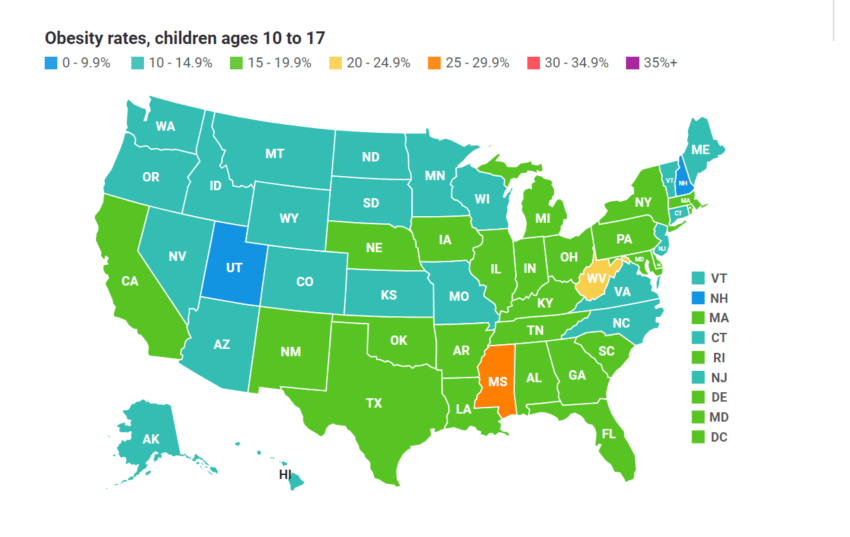
Share On Social!
Nationwide, 20.6% of Latino youth and 22.5% of Black youth have obesity compared to 12.5% of white youth, according to a new data report from the Robert Wood Johnson Foundation (RWJF).
The new data feature obesity rates among youth ages 10-17 nationally and from each state from the 2016 and 2017 National Survey of Children’s Health (NSCH), along with analysis conducted by the Health Resources and Services Administration’s Maternal and Child Health Bureau.
Five states have Latino youth obesity rates over 30%.
No states have White youth obesity rates over that mark.
“Far too many young people in this country are facing increased chances of diabetes, heart disease, and high blood pressure, all due to a preventable condition … black and Latino youth are still more likely than their white peers to face these problems,” said Jamie Bussel of RWJF in a news release.
“We must help all children grow up at a healthy weight, so they can lead healthy lives, and save the nation billions in healthcare costs.”
Fast Facts on the New Data
The national obesity rate for youth ages 10-17 in 2016-17 was 15.8%.
But Black youth had nearly double the rate (22.5%) as white youth did (12.5%). The rate for Latino youth falls between those two, at 20.6 percent, and Asian youth have the lowest rate, at just 6.4 percent.
Obesity remains one of the biggest threats to Latino health, with significant financial and societal implications, particularly for southern states.
Nine of the 10 states with highest youth obesity rates are in the South, according to the new data.
Mississippi has the highest youth obesity rates at 26.2%.
The following seven states have Latino youth obesity rates higher than 26.2%: Georgia, Indiana, Kentucky, Louisiana, Maryland, Massachusetts, and Rhode Island.
Children with obesity are more than four times as likely as healthy weight children to become obese by the time they were 14.

The new youth obesity data augment data on adult obesity rates in the recent 15th annual State of Obesity: Better Policies for a Healthier America report from RWJF and Trust for America’s Health.
That report found adult obesity rates over 35% in seven states. It also had interactive briefs for each state with new data on obesity-related health issues, like diabetes and hypertension.
Each year, the United States pending $14 billion on childhood obesity alone, and between $147 and $210 billion on adult obesity.
Helping children and families maintain a healthy weight from an early age is essential to prevent mental and physical health problems and to save billions in health care costs.
Policies to Prevent Obesity
Strong national and state policies play a key role in alleviating the conditions for obesity.
If you are not familiar with the role policies play in health disparities, read 8 Policies that Have Contributed to Place-Based Health Disparities Across Generations from ChangeLab Solutions.
The recent State of Obesity report also called for strong national and state policies to help children and families maintain a healthy weight from an early age.
The specific policy recommendations to federal policymakers, state and local policymakers, the food and restaurant sectors, and healthcare providers and systems to prevent obesity in early childhood education settings, schools and communities include:
- Congress and the Administration should maintain and strengthen essential nutrition supports for low-income children, families, and individuals through programs—like the Supplemental Nutrition Assistance Program (SNAP), the Child and Adult Care Food Program (CACFP), and the Special Supplemental Nutrition Program for Women, Infants, and Children (WIC)—and expand programs and pilots to make healthy foods more available and affordable through the program.
- The U.S. Department of Education should maintain the Office of Safe and Healthy Schools, as well as Title I and Title IV programs under the Every Students Succeeds Act (ESSA), through which schools can receive funding for physical education and physical activity initiatives.
- State should support efforts to make Safe Routes to School programs universally available and secure state-level appropriations or Transportation Alternatives program allocations for both infrastructure and no infrastructure projects.
- At the state and local level, require that all road construction and reconstruction projects adopt a Complete Streets approach, ensuring that transportation plans are safe and convenient for all users.
- States and localities should ensure all restaurant meals marketed to children meet nutrition standards, and remove sugary drinks from all restaurant children’s meals.
- Hospitals should no longer sell or serve sugary drinks on their campuses; they should also improve the nutritional quality of meals and promote breastfeeding.
Check out the state briefs in the State of Obesity report for obesity rates, other obesity-related health issues, and status of state efforts on state policy.
You can also look for state-specific policy recommendations in early childhood education settings, schools or communities.
Share one or more of these recommendations with the elected officials who represent you and tell them why they are important for you and your community.
Editor’s Note: Due to changes in the National Survey of Children’s Health mode of data collection and sampling frame, it is not possible to directly compare results from the 2016 or 2017 surveys to earlier iterations.
By The Numbers
33
percent
of Latinos live within walking distance (<1 mile) of a park



